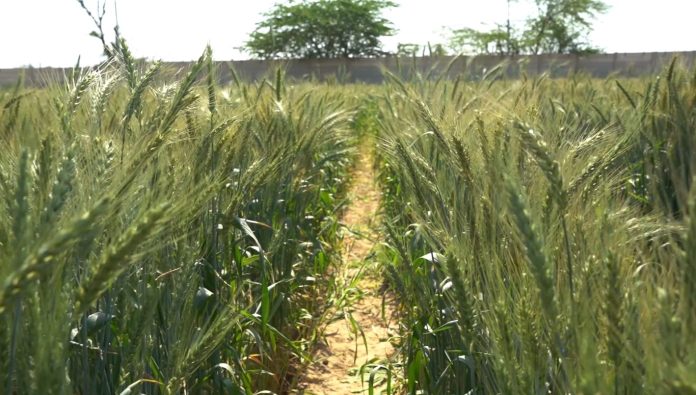“As you know that at the end of the season, we face a shortage of wheat. Keeping this in mind, we did the intercropping of wheat with sugarcane,” said Dr. Imran, who is managing sugarcane-wheat intercropping at the National Research Center of Intercropping (NRCI).
“We plant sugarcane on 31 lakh acres of land in Pakistan. If we utilize 50 percent of this area for intercropping, we can get an average of 70 percent yield of our total production. Besides, as this sugarcane plant starts growing after 120 days, if we utilize this property of sugarcane and get 25 mounds of wheat per acre during this period, then we can save the millions of dollars spent on import,” explained Dr.Imran.
Now multiple sugarcane-based and wheat-based intercropping crops are planted as experiments by NRCI which was established in 2021 in the Islamia University of Bahawalpur with the collaboration of China.
Similarly, Dr.Atta told the reporter how he planted sugarcane-raya intercropping. “We kept a distance of 1 foot between them. In the shades of Raya plants, there forms optimized light and temperature. So we are expecting more yield. In addition, there are no weeds. After raya dropped down its leaves, these leaves will give sugarcane organic matter.”
According to him, after harvesting the raya crops, they plan to plant soybean as the soil is ideal for its growth. “We will get three crops from it without adding any extra fertilizers and water,” said Dr.Atta, noting that this sugarcane-raya intercropping system has been the most successful intercropping so far, which will increase production of raya and edible oil after being shared with farmers.
Sugarcane-based intercropping system now focuses on sugarcane intercropping with chickpea, maize, brassica, berseem, wheat, and pea. After the sowing of sugarcane, the initial 120 days is the gap when the growth is very slow. Farmers can utilize the extra space between two rows for the cultivation of other crops without using extra water and fertilizers.
While the idea behind wheat-based intercropping is to decrease the wheat lodging problem by introducing strips as a wind pressure breaker and introducing legume crops to maintain the health of the soil and improve biodiversity. Wheat-based intercropping system now includes wheat intercropping with chickpea, maize, brassica, and berseem.
“Countries like Pakistan need intercropping because it is a challenge to provide food to the growing population. It ensures food security and helps farmers earn a reasonable income,” said Dr Muhammad Haider Bin Khalid, Deputy Director, NRCI.
According to Prof. Athar Mahboob, Vice Chancellor, Islamia University of Bahawalpur, there is potential in intercropping as from 1-acre land, it can get 1.5 to 2 acres’ production. “Our scientists have successfully and sustainably produced equal to 1.4 acres’ production so far and have rolled out the technology. Intercropping is a highly promising technology on our scarce and precious agricultural land,” he said.
These experiments were designed after reading the work of Li Long and Fusuo Zhang from China. Experts from Sichuan Agricultural University (SAU), China and Gansu Academy of Agricultural Sciences (GAAS),China are helping in designing and developing these intercropping systems. This project has also been included in CPEC.
“I think that our cooperation with China in agriculture is increasing and is in the direction of upward path. So, we hope that more initiatives will come from the CPEC platform that will prove to be a facilitator for further cooperation in the agriculture sector,” said Prof. Athar Mahboob.
To give training to farmers, NRCI has published literature and books using an easy-to-understand language. Besides, it also has agreements with different large farmers where they can help farmers by placing trials on their sides.
NRCI has developed machines like planters and harvesters which are needed for intercropping. NRCI has obtained the patents for these machines and now is giving know-how to farmers. The machinery is also designed through cooperation with Chinese partner universities.


